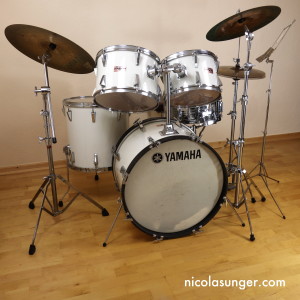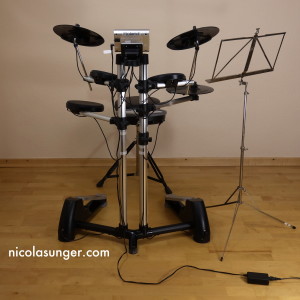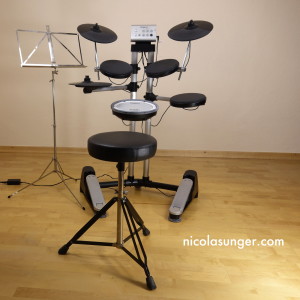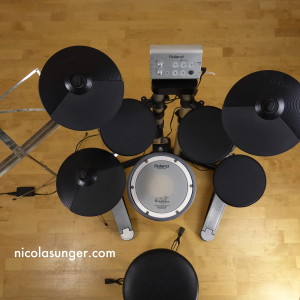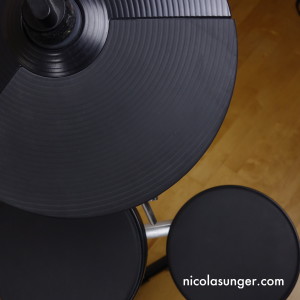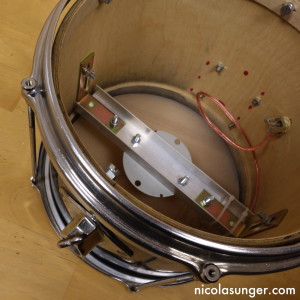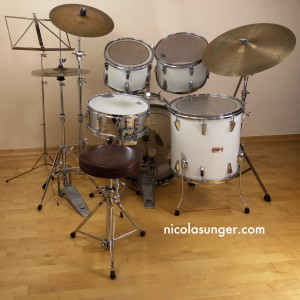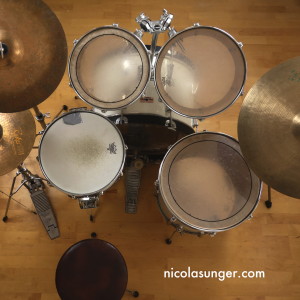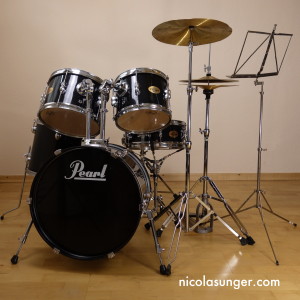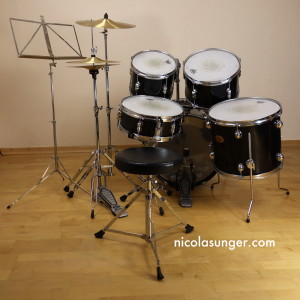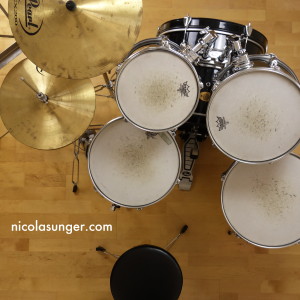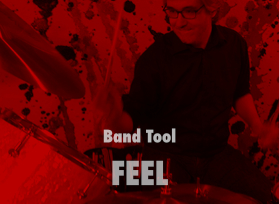This is how you start with drums!
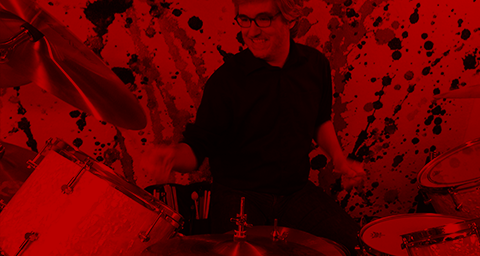
9 comprehensive basic tips on how to start drumming.
This is the place to be!
In this article you´ll get 9 tips from different angles, so you can decide what is best for your individual situation.
In my article I´ll answer the following questions:
1. Which drum set is right for me?
2. Where can I play if I can´t play at home?
3. How do I find a teacher?
4. How do I use internet drumming videos the best way?
5. How do I find my own drumming path?
6. How often shall I play?
7. How do I determine my next learning steps?
8. How can I measure my learning progress?
9. Where do I meet other musicians?
Let´s get started with the answers!
1 – WHICH DRUMSET IS RIGHT FOR ME?
First: Decide between an acoustic and electronic drum set.
Here is what an electronic drum set is offering you:
It´s much softer than it`s acoustic sibling. That is much more pleasant for your surroundings. But still: Even an electronic drum set produces sound: Impact sound coming from the sticks hitting the rubber or mesh head drum pads and especially from the beater of the bass drum pedal hitting the bass drum pad. This is the loudest sound coming from an electronic drum set. It can drive your neighbor crazy because it sounds like your hitting with a rubber hammer on the floor or the walls (the walls carry the sound coming from the floor). Neighbors can´t identify these sounds as “musical”. It´s just an “ant war” consisting of deep noise (from the bass drum) and clicking sounds from the pads interrupted by other louder clicking sounds (from the cymbal pads).
If they ask you what is going on you should politely inform them of your new instrument and that you are ambitiously learning. And to protect them from the sound level of an acoustic drum set you decided to play with the electronic one. At this point many neighbors identify with your ambition and support you. If not try to arrange a time of day when you can play and which is ok with your neighbor. That way he and you can accommodate to the new situation.
Usually the drums can´t damage a good relationship with a neighbor but can´t improve a bad one.
Perhaps you can provide a remedy by placing your drum set on a impact noise isolating platform. Additionally you can use an impact noise reducing drum set without a bass drum beater:
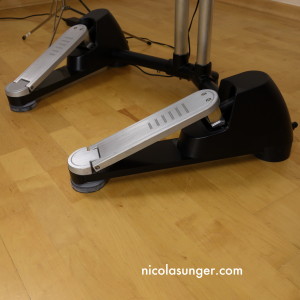
New E-Drums can be expensive. But a used electronic drum set can be a very good option.
You should sweep used E-Drums for the following points:
– Play all the pads. Never buy a dismantled instrument!
– Pads with severe playing traces should be thoroughly tested: Play very soft to check the sensitivity.
– Bring your own headphone and a tuning key. Sometimes both are neither included in the offer nor available on site.
– Check all the bolted connections for function and stability. You don’t want that one famous pad that adjusts itself with every hit.
– Try the sensitivity of the bass drum pad. The sound has to appear with normal kick force. Stability is a given.
– Both pedals shall be in a condition where the mere pedal movement makes no disturbing sound.
– Is the drum set still under guarantee the price will be higher.
– For older E-Drums I personally would not pay more than half of the original price. But often these instruments are offered for more than that. Compare all the prices you can find and determine your limit.
Generally there are four different surfaces on e-drums:
– The old very hard plastic surface with very little rebound:
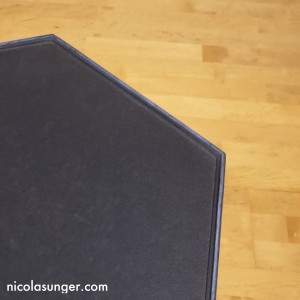
– The soft rubber surface with bad sensitivity leading to skipped strokes and therefore to a heavier playing “into” the surface. The rebounds are absorbed by the wrists possibly leading to ganglions.
– The high quality rubber surface with a very good rebound. It nearly matches the playing feel of an acoustic drum.
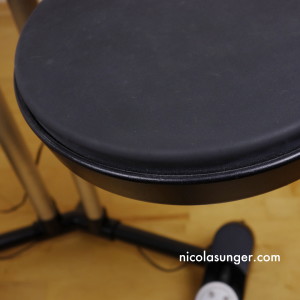

– Tensioned mesh head featuring high sensitivity and a rebound quality so good that you may have to adapt when playing an acoustic drum set – especially when the tom pads are mesh heads.
I recommend mesh heads and high quality rubber pads. For an electronic drum set with the described quality features you may have to pay more as for an acoustic drum set with acceptable features:
If you are good with your hands you can transform an acoustic drum to an electronic drum by installing a trigger and mesh head:
Here is what an acoustic drum set is offering you:
– Authentic feel: Drums and cymbals directly react to your actions. The different impulses are transmitted steplessly to the instruments. You´re getting a instant feeling for the sounding effects of your playing. The high level of sound can be stress for your neighbors.
Ther is a variety of drum sets on the market by many different manufacturers such as DW®, Pearl®, Mapex®, Yamaha®, Sonor®, pdp®, Tama®, Gretsch®, Ludwig®, Kirchhof®, Wahan® and more for drums. Manufacturers of cymbals are Meinl®, Paiste®, Sabian®, Zildjian®, Istanbul®, Ufip®, Masterworks®, Agean®, dream® and more.
Every manufacturer offers distinct products starting from relatively advantageously priced instruments for the beginner.
The standard drum set consists of five drums (four if you´re going to be a jazz or punk drummer or just looking for a different look and/or feel of your instrument). The diameter of a drum or cymbal is indicated in inches:
22″ Bass Drum
14″ Snare Drum
12″ Tom (high)
13″ Tom (medium)
16″ Floor Tom (low)
The depth of the drums depend on your body height. Very deep toms (“power toms”) force you to sit higher or placing them extremely tilted to be able to reach the foot pedals. Compare the sitting positions of Chester Thompson (Foto by tonydrums) and Nicko McBrain (Foto by Nick Pickles).
Differing from the standard sizes there are “fusion sizes” and “jazz sizes”:
Fusion:
20″/14″/10″/12″/14″
Jazz:
18″/14″/10″/14″ or quite similar small
There are drum kits for persons small in height in the following sizes:
18″/14″/10″/12″/13″
The original cymbals here are of minor quality. Sometime in the future you need a complete set of new cymbals (with an additional cymbal stand). Only the soft hitting player is able to play these cymbals for a long time. The cymbals of a heavy hitter will soon look like this:
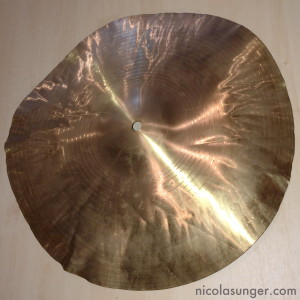
In general three types of cymbals belong to a standard cymbal set:
Hihat cymbals (two cymbals which can be played by hitting them or stepping on the pedal of the hihat pedal causing the cymbals to clash. Sounds like “Tz” or “Chick”). The standard diameter is 14″.
Crash cymbal (sounds like “crash” ;-). Diameters vary from 14″ to 20″.
Ride cymbal (sound like “Ping”). Diameters vary from 18″ to 22″.
Here is what you need:
Two pedals
Pedal 1: Hihat pedal
Pedal 2: Bass drum pedal
Stands
Stand 1: Snare Drum
Stand 2: Ride Cymbal
Stand 3: Crash Cymbal
Stands 4 and 5: Your hanging toms are either mounted via multi clamps on your two cymbal stands (note: you move your toms the cymbals move too) or via a tom mount on your bass drum.
Sticks
For a start I recommend 7A sticks for smaller hands and 5A sticks for larger hands. Note: You have to try out your sticks! Don´t just buy anything.
A drum throne
A music stand
A tuning key
Used drums – Please note:
– Used and/or cracked drum heads aren`t a problem. They are easy to replace if you´re keeping my upcoming tuning tips in mind.
– Initial easily removable rust on some metal parts of the instrument isn´t a problem. If there are heavily rusty parts even inside the drums it is a sign that the instrument has been kept in moisty surroundings. Wooden drums can be warped because of that. Check the edges of the drum (junction of drum head and rim) and try to determine if it´s perfectly round.
Also check if the tension rods are equally tightened. Long unequal tension may buckle both the rim and the drum. Fitting new drum heads to such drums may be impossible.
– All moving parts have got to move (pedals, stands, bass drum feet, wing bolts, tuning rods).
– Only inspect built drums! Don´t buy a “bunch of parts”. Ask the seller if the drum is built and ready for testing.
– Don´t buy drums with missing rims. Usually the tension rods are also missing. You may end up with rattling tuning lugs and have to invest time and/or more money to repair the drum.
– Look inside the drums (if they are fitted with two white drum heads look through the air hole)
– Cymbals are not allowed to have cracks or a keyhole (ovally and/or off-centered deformation of the hole in the middle of the cymbal). You may notice such a keyhole as recently as you remove the felt from the stand usually covering the hole. Therefore see over the cymbals.
– Cymbals covered with verdigris or fingerprints aren´t automatically bad cymbals. They can actually sound very good. So let your ears decide.
– Remind yourself of the numbers: 5 Drums, 3 cymbals, 2 Pedals, 1 Throne, 3 stands + 2 tom holders (+ multi clamps). If all that´s a given, the instrument sounds ok, the price is right and you have a good feeling about it, you can buy.
One more tip: Some (private) sellers are posting fotos of a complete drum set but only selling the drums (with no cymbals). Look out!
You can treat most acoustic drums and improve their sound quality with new drum (and resonating!) heads. Therefore a cheaper acoustic drum set is playable for years. Used E-drums with sustainable quality are more expensive than acoustic drums. Sometimes you`ll be able to get your hands on warranted used e-drums.
Note: If you´re already knowing your preferred style of music, you can buy a special drum kit like a jazz set or a kit with two bass drums. But since you´re just starting and wanting to play the drums this is probably not the case.
2 – WHERE CAN I PLAY IF I CAN´T PLAY AT HOME?
There are (free or fee-based) possibilities which may face you with challenges and may require some courage on your part. But nothing stands in your way, right?!!
Perhaps there are institutions nearby like a youth center, civic center or a church. Some of them might already have a room for musicians. Look them up and ask them, AND think about what you can offer them in return if the usage of the room is free of charge.
In rural areas sometimes a farmer owns a barn with a little untapped room in it. That´s all you need. Ask in the town hall if there is an old garage, part of a train station or unused (small) building. Talk with your circle of friends and acquaintances about your new hobby. Involve them into your project in finding a rehearsal room.
The good old stub always helps. Post it everywhere where it´s legal. Be very clear and also add a little foto or drawing of a drum. Post a precise want ad on the internet that mentions that you are reliable. Please remember to include the information WHERE you need the room…
Rehearsal rooms in old train stations, industrial buildings and special buildings for musicians and bands often are (very) expensive. But all you need first is an overview of the possibilities in your area. So contact the nearest music store. They know the environs. You have to talk to them end put your stub there. Perhaps there is a possibility becoming the lodger in a band rehearsal room paying a share of the rent. Bands sometimes are interested in finding a single musician (instead of another whole band) reducing their rent.
3 – HOW DO I FIND A TEACHER?
An online search might help. Check the stubs in every music-associated building there is. You will find many teachers. But not every teacher is the right one for you. And you need to find the right one!!! So take some trial lessons with different teachers. Ask them about their teaching methods. Do they have a master plan, a philosophy, a standard book they use?
But most importantly you have to be able to connect to the teacher. Otherwise you won´t be able to benefit from the lessons.
Check if the teacher adapts to you. Sometimes it´s too much, sometimes too little. Does the teacher inspire you? If you can´t connect to the teacher and asking questions is not possible you´re better learning with online videos.
A good indicator for common ground is attitude and humor. Did the teacher make you smile? Did you feel free to ask a question? Music is communication. Teaching is communication. If you and your teacher are able to communicate you´ll become a better drummer.
Note the payment terms. Read them properly. Never sign a contract during the trial lesson! A reliable teacher will accept respite.
4 – HOW DO I USE INTERNET DRUMMING VIDEOS THE BEST WAY?
You must understand that every advice is shaped by the experience of the one who is giving it. Keep that in mind when watching drumming videos. So the educational background of a drummer is crucial. A rudimental snare drummer will give you other tips than a self-educated drummer or an orchestral snare drummer or jazz drummer. Their own (practical and life-) experiences and musical contexts shape their points of view.
Therefore in my articles I´m trying to give a neutral perspective to be informative and non-constricting where it´s necessary. So you can ponder which aspect of a topic is most relevant for your situation.
Ok, back to answering question:
Start with the drummers of your favorite bands. Watch videos of the original songs. Then watch some drum covers and drum tutorials. Compare the original with the covers. Make notes and analyze the challenges of every particular song. Create exercises. Start difficult parts very slow and play them in changing combinations of loops. Decide whether you want to play a version a 100 percent true to the original version or come up with your own.
That way you can come far. With a teacher you can come even farther. You benefit from the teachers immediate response to what you´re playing and the possibility to further inquiry. A little remark and/or some hints on your playing technique can save you weeks of research and listening. So the money for the lesson is well spent.
5 – HOW DO I FIND MY OWN DRUMMING PATH?
I don´t know you personally. But I can tell you how I handle this question with my students:
You have to understand that everything is possible and that in the learning process to a certain amount you have to fight for your staying open minded. Why? The more you know and the more you´re able to play the more can possibly go wrong. And the first rule reduces your cosmos of possibilities. As long as you know nothing about drumming you´re unable to play something wrong. That is why so many musicians say: “To be able to play music, you have to forget what you`ve practiced.” Thats´s the problem with “just” practicing. You have to transfer every new topic you practice into an ability. So you have to play it. You have to incorporate it into the pool of your own abilities. Or as Adam Nussbaum put it: “You have to know it”. You`re not allowed to reflect about what you´re doing while playing music. Music has to be felt. Thinking is ok, but not contemplation.
What´s the solution to all this? My answer is simple: Play! Play! Play! Play all the time, even when you normally would be in “practicing mode”. How? My answer is even simpler: Don´t make mistakes. Never! Why is that? Everything you do, reflects back into your brain. You get accustomed to what you´re doing. So mistakes cause a little “trail” on the untouched meadow which is your brain. So when you´re not making any mistakes you´re tramping down the right trails and the only mistakes that happen are happening because of weak concentration but not because you´re not able to play what you want. These two types of mistakes are completely different!
How do you do that?
You have to play slowly what you can not play fast.
This simple advice is the hardest to implement. You want to play. We are drummers. We want to play. We want to play fast – especially what we know our stuff sound-wise. But to be able to do that: You have to become conscious of the imminent task for your motor and coordination skills. Fast tempi are an obstacle to consciousness – for new stuff. Consciousness needs slowness. That generates a great sureness. Sing, count, cut the groove to get a view on the coordination, play as if you´re playing under water, sing and play and invent variations of the current music. Play it the whole time. Be present. Feel everything you do. Only so you fill the pool of your skills you later can draw on. When playing in a band you can not draw on “just” practiced material. The audience will say: “Nicely practiced” but not “Wow, that felt great. I loved it.”
From that you can start to raise the tempo. Either you´re new practicing material will more and more internalize and become a new skill or it meets with your already existing musical knowledge and feeling for your the music.
Stay with your current learning topic as long as it is internalized and has become a part of your musical knowledge. Stay calm and be patient. Focus on the topic. Don´t let your concentration slip away. Focus! Focus on your topic like you would observe a single star in the universe. Right now all the other stars are of no concern. But by working on one topic we´re working on everything.
There´s always one thing to learn first. The second thing should follow logically. At this point often my students butt in and turn the lesson in their direction. For me is this one crucial moment because I´m now able to get a short glance on what drumming means for the student. It´s not accidental. It´s something logical for the student. If I follow the student, I support him immensely because the following experiences resting on the students own decision and are therefore much more meaningful and relevant. Everyone of my corrections and instructions will be much more meaningful for the student. We learn from each other as we go along. My beginning students off all ages start with my book START. It covers all basic topics of drumming in a very simple way and is suitable for beginners of all ages.
For you is important to understand that every single idea of yours can be a significant one. So follow every single one. Write down your ideas and questions. Don´t let them go easily. Every single one can become the nucleus, the first step on your own way through the world of drumming. You have to follow your ideas. How else con you develop your own voice on the instrument?
Here comes your boldness into play to follow your ideas consequently. Sometimes you are distracted or unsure. That´s not important. Stay with it. The teacher feels your creativity and gives you suggestions and accompanies you. Sometimes the teacher takes the lead and sometimes the student. At least that´s my teaching style. It works very well with me and my students. But I´m so completely undogmatic and flexible that sometimes I´m using a book with a student for quite some time. It´s what the student needs what determines the means and methods of my drum lessons. And the student has more a say in the lesson´s topics as older he or she gets.
If you don´t have a drum teacher or just stopped seeing one because you needed a break: Stand beside your drum throne for some seconds and then celebrate the sitting down. Now take the sticks and concentrate on your breathing. Close your eyes and just sit. If you have an idea that has to be played, play it. Mean it. What you play is irrelevant. It has to be felt. It can be everything. Feel this universe of possibilities, let go of all your expectations and wantings and start freely to play what YOU feel.
6 – HOW OFTEN SHALL I PLAY?
Primarily you should find other musicians as soon as possible! This may sound surprising, but it is the crucial step! Then you play at home to be fit for the (later) interaction with your band. So it’s not about the “practice” for practicing sake, but a goal that you name for you. Since drumming is a “team sport”, you develop your playing only in interaction with others in a meaningful and musical direction.
My early doctrine was that you first exercise and exercise and then apply the trained (hopefully musically). But who does not practice musically which means constantly plays, has no “feeling catalogue“ on which he can draw when he interacts with other musicians. Practiced patterns and rhythmic recipes are very useful, but not applicable for just themselves. While practicing musically they must be integrated properly into the cosmos of feelings of the player. Then shurely a lively-sentient interaction with other musicians is possible.
So I have come to believe that in the learning process you have to constantly and always play . You`re not practicing playing in a sandbox as a child. You`re just doing it. There is nothing theoretical about it. There is no textbook, which you must study in order to understand how to do that. The experiences in doing things matter! And with this approach you will become constantly a better and better sandbox-player.
Learning to play the drums is exactly the same. At first there are no rules. You can make mistakes. You´re allowed to develop and implement your own ideas. You´re allowed to play. Even small learning goals – often called “exercises” – must always be felt and played, or played until they are felt (!). You have to play with an idea in your head, otherwise you lose the contact of your feeling to your playing. In other words: Your playing loses its sense and thus it`s actual musical ground and meaning.
Therefore all of my posts in this blog don´t deal with the blunt-technical practicing without any sound idea in the mind of the learning musician, but with the playful learning. Make the learning steps always so small that you`re able to play everything imediately – albeit at a slow pace at first (!). Can´t play everything idediately: You´re playing too fast!!! So at first play so slow that you can (!) play. This simple rule is, de facto, the most difficult.
Taking this rule to heart you from the beginning you will achieve the maximum learning effect, because you make almost no „can´t-do-errors“
(you successfully turned off excessive demands) but only (slight) concentration error because you always have a sufficient reserve of „working memory” available in your mind. This creates joy of learning (learning frustration is completely eliminated) and the desired flow arises in your mind, your feel and your musical playing.
To return to the initial question: play as often as you can! Preferably 30 minutes per day. The drumming is, at best, a natural part of your life and enriches (it) every day. Then you play for yourself, not for a book or your teacher. Hereby learning is easy for you. And if you’re taking lessons they become a motivation not a duty.
7 – HOW DO I DETERMINE MY NEXT LEARNING STEPS?
The steps involved in learning drums are always the same:
1. Get a sound idea
a) by listening to your teacher playing the music to you
b) by counting extremely slow and playing correctly. This results in playing always accurately while making no mistakes. Thereby you collect certainty. You`re listening to yourself learning about the correct sound and structure of the music (even if your teacher did not play it for you!). Incidentally you`re getting more and more independent that way.
2. The more confident you play, the faster you can play.
3. You can recognize the sound more clearly and the rhythm also flows better and better.
4. You can play some passages by heart and will begin begin to skim the notes.
5. You’re confident and you complete this learning step.
6. You`re dealing with similar learning content (a rhythm, a groove or a snare text) and you improve your reading ability and range of variation.
The following learning step can not be small enough !! Take the stress of learning completely out. You want to have joy in playing. Have the courage to allow yourself some time!
Rather play less stuff extremely good than many things indifferently. You can not realize these goals independently, take some lessons!Take notes of what the teacher tells you. Often the important information that can change your life as a drummer is put in a subordinate clause.
8 – HOW CAN I MEASURE MY LEARNING PROGRESS?
Record a good version of a completed learning content with phone, voice recorder or the like and collect your recordings. With the second recording you will notice your progress. Always write down the next small learning goal. Check it off once you reached it. Do that in a notebook adding the date and you have your own training diary in no time.
A metronome can help you determine your pace increases. Do you have difficulties working with the metronome, you can do without it (at first).
Written notes are enough. For certain learning content you can also keep lists and create plans that you process.
9 – WHERE DO I MEET OTHER MUSICIANS?
You can approach musicians after their concerts. You can attend live sessions and learn about the requirements for a drummer in such a situation. Musicians rehearse in youth centers, rehearsal room buildings, and many other places. If you’re looking for a musician to play together, you can post your bill there. And: You meet a musician who will play with you when you´re ready. Therefore you should start playing with another person as soon as possible for being ready :-). This may be a keyboard or piano player, a guitarist or bassist.
Have the courage to seek teammates immediately. They`re waiting for you to make the first step! :-) Nothing can go wrong. Cheer up!
If you play with others: Learn all the songs by heart! So you can concentrate on your core tasks timing, leading and the music.
I hope my tips help you beginning to play drums!
Leave a comment if I could help you!
Until the next post.
Nicolas Unger
www.nicolasunger.com
